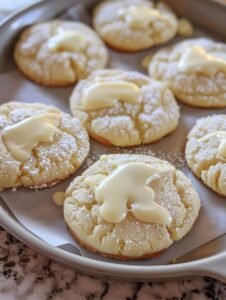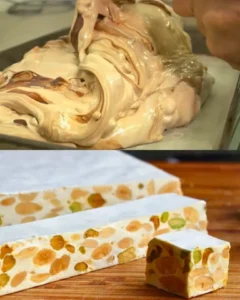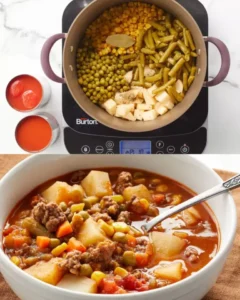Classic Homemade Bread: Simple, Soft, and Delicious
Introduction:
There’s something incredibly cozy and satisfying about the scent fresh bread floating throughout your house. The Classic Homemade Bread recipe yields an easy, delicious bread with a soft airy interior and golden-brown crusty outside. If you like it toasty using butter for sandwiches or to simply enjoy the soft, warm texture it is an example of the pleasures of baking at home.
Why You’ll Love This Recipe:
- The simplest ingredients: This recipe utilizes ingredients from the kitchen, which makes it affordable and cost-effective.
- Simple to follow: The instructions are simple and easy to follow, making them suitable for experienced and novice bakers.
- Flexible: This bread can be eaten in a myriad of ways. It is the perfect accompaniment to any dish.
- Rewards: The satisfaction of making your own loaf of bread will never be matched and the delicious result will make you want to bake your bread again and more.
INGREDIENTS YOU’LL NEED:
For the Dough:
- 2 1/4 cups warm water (105-115degF/40-46degC)
- 2 1/4 teaspoons of active dry yeast (1 normal packet)
- 1 tablespoon of sugar granulated
- 3 1/2 cups of bread flour
- 2 1/2 cups all-purpose flour
- 2 teaspoons of salt
- 2 teaspoons olive oil (or melting unsalted butter)
HOW TO MAKE CLASSIC HOMEMADE BREAD:
STEP-BY-STEP INSTRUCTIONS:
-
Test the yeast: In a small bowl, mix the hot water, yeast and sugar. Let it stand for 5-10 minutes to ensure that the liquid is foamy and bubbly. This means that the yeast is in active and is ready for use.
-
Mix the dry ingredients: In a large mixing bowl, mix together ingredients such as bread flour, all purpose flour as well as salt.
-
Make the Dough:
- Form a well into the middle of the dry ingredients.
- The yeast mix that is proofed along with the olive oil (or melting butter) into the well.
- Utilizing a wooden spoon or your hands, slowly blend the wet ingredients in your dry ingredient until you have a slimy dough develops.
-
Knead the Dough:
- Move the dough onto an area that is lightly floured.
- Knead for about 10-12 minutes for up to 10-12 minutes, or until the dough turns firm and smooth.
- If your dough is difficult to handle, use a bit more flour, about a spoon at a.
-
First Rise (Bulk Fermentation):
- Cleanly coat a bowl using olive oil and cooking spray.
- Put the dough into the bowl and turn it over to cover all sides with oil.
- Wrap the bowl in the plastic wrap or clean kitchen towel. Let the dough rest in a cool, air-free location until the dough has the dough has doubled in size. This could take about 1-1.5 hours.
-
Shape the Dough:
- Make sure you gently smack the dough until it releases the air.
- Make your dough in a loaf. Then set it aside in a well-greased 9×5 inches loaf pan.
-
Second Rise (Proofing):
- Place the loaf pan in a loose cover by wrapping it in plastic wrap or a kitchen towel.
- The dough should rise in a warm area until it is about one inch higher than the edge of the pan. It should take around 30 to 45 minutes.
-
Bake the Bread:
- Pre-heat your oven to 375degF (190degC).
- Baking the bread 30 to 35 minutes or until the crust is golden and the bread is hollow when you tap it.
- If the skin is turning brown fast, wrap it in aluminum foil.
-
Cool and Enjoy:
- The bread should be removed from the pan, and allow it to cool completely on a rack prior to cutting and serving. Enjoy!
HELPFUL TIPS:
- The temperature of the water: Be sure that the water cool, not hot since hot water may cause yeast to die.
- Kneading Kneading is essential in the development of gluten that gives bread its shape. Do not rush the process!
- Warm Environment Warm, air-free location is perfect for rising. It is possible to create an environment that is warm by placing your bowl in an oven with a little warmth (turned off) or next to a bright windows.
- Test for Doneness Apart from the sound of a hollow sound when tapping the instant-read thermometer that is placed in the middle of the loaf will read between 190 and 200 degrees (88-93degC).
- It is important to be patient: Allow the bread to completely cool before cutting to avoid it becoming sticky.
DETAILS:
- Prep Timing: 20 minutes
- Start Time: 1.5 or 2 hours
- Cook Time: 30-35 minutes
- Total Duration: Approximately 3 hours
- Yield 1 loaf
- Category: Bread
- Method: Baked
- Cuisine: International
- Diet: Vegetarian
NOTES:
- To get a more savory flavor it is possible to substitute 1 cup of all-purpose flour for whole-wheat flour.
- For a hint of sweetness, try adding one tablespoon of honey or molasses in the dough.
- If you would prefer a more soft crust, lightly brush the surface of the loaf the melted butter or milk prior to baking.
FREQUENTLY ASKED QUESTIONS:
- Do I have to use instant yeast in lieu of dry active yeast? Yes, you are able to make use of instant yeast. Just add it directly to dry ingredients without the need to proof.
- What caused my dough to not grow? Several factors can influence the rise of your dough, such as how hot the water is, quality of the yeast as well as the conditions in which the dough is rising. Make sure the temperature of the water is moderate, not boiling as well as the yeast is clean and that the climate for rising is cool and void of drafts.
- What is the best way to store bread that I make myself? Store cooled bread in a bread container or airtight containers at room temperature for 3 to 5 days. If you want to store it for longer time then you could freeze it.
STORAGE INSTRUCTIONS:
- Room Temperature Place in a breadbox or airtight container in room temperature for 3 to 5 days.
- Freeze The bread is wrapped with plastic wrap tightly followed by aluminum foil. The bread can be frozen for three months. Then, let it thaw for a few hours at room temperature or in a refrigerator.
CONCLUSION:
Baking bread at home is satisfying, and the Classic Homemade Bread recipe offers the perfect and easy approach to get started. Utilizing only the basic ingredients and simple instructions, you’ll soon be enjoying the scent and flavor fresh bread right in the comfort of your kitchen. Happy baking!



